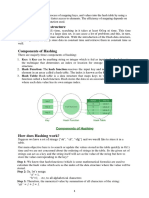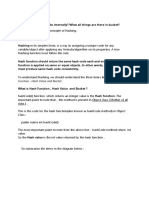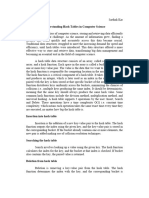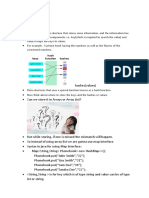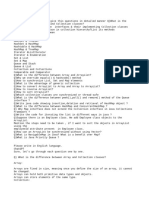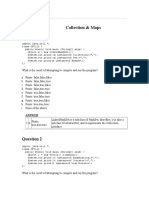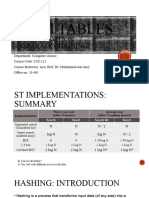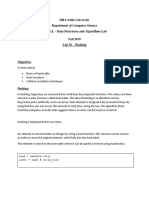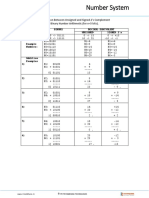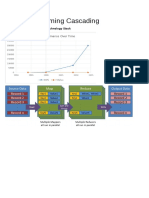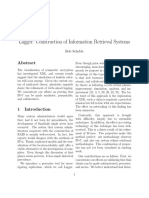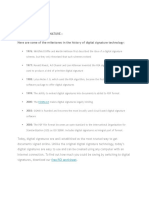Case Study: Hashmap Performance Improvement in Java 8
Case Study: Hashmap Performance Improvement in Java 8
Uploaded by
rajaCopyright:
Available Formats
Case Study: Hashmap Performance Improvement in Java 8
Case Study: Hashmap Performance Improvement in Java 8
Uploaded by
rajaOriginal Title
Copyright
Available Formats
Share this document
Did you find this document useful?
Is this content inappropriate?
Copyright:
Available Formats
Case Study: Hashmap Performance Improvement in Java 8
Case Study: Hashmap Performance Improvement in Java 8
Uploaded by
rajaCopyright:
Available Formats
Case
Study: HashMap in Java
www.ritambhara.in
Case Study: HashMap performance improvement in Java 8
Java language’s utils package has HasMap class that implements Map interface using a hash table. It
implements two constant-time functions put and get that stores and retrieves values in HashMap.
HashMap stores information in Key-Value pair as demonstrated in Code 3.1.
import java.util.*;
public class RTDemo
{
public static void main(String args[])
{
HashMap<Integer,String> hash = new HashMap<Integer,String>();
hash.put(1000, "Ritambhara");
hash.put(2000, "Moksha");
hash.put(3000, "Radha");
System.out.println("Value for 1000 is: " + hash.get(1000));
System.out.println("Value for 2000 is: " + hash.get(2000));
System.out.println("Value for 3000 is: " + hash.get(3000));
}
}
Code: 3.1
The output of Code 3.1 is
Value for 1000 is: Ritambhara
Value for 2000 is: Moksha
Value for 3000 is: Radha
HashMap<Integer,String> declares a HashMap with String values stored on Integer keys.
Obviously, the implementation cannot keep an array of size 3000 to store these values. The key is passed
to a hash function that generates a smaller value indicating index in the actual hash table, something like.
Index = hashFunction(1000);
let us assume that size of hash table is two1 and hashFunction2 is as below
int hashFunction(int n)
{
return n%2;
}
Index for 1000, 2000 and 3000 are 1, 2 and 1 respectively. Both 1000 and 3000 generate same index.
This is called Collision in hashing. There are multiple ways to handle collision, one of them is thru
chaining.
Hash table holds a pointer to the head of linked list of records having same hash value.
1
Size of hash table is usually higher so that each bucket holds (preferably) single entry.
2 HashMap in Java uses hashCode() and equals() method of key.
© Ritambhara Technologies. +91-8377803450 krawat@ritambhara.in
Case Study: HashMap in Java
www.ritambhara.in
Calling get function with key 3000, retrieves the value in two steps:
1. Find the index of hash table that stores key 3000 using same hash function. This value comes out
to be 1.
2. Traverse the list of index 1 in the hash table to find record corresponding to key 3000.
In worst case, all keys correspond to the same index. Searching in such a hash table takes O(n) time. But
this is an almost impossible situation for a good hash table implementation. However, there are possibilities
that individual linked list has many values.
As you can see each collision has a direct impact on performance. Since searching in a linked list is linear,
worst-case time is O(k), where k is number of nodes in the linked list. What java-8 has done is, when a
linked list has more nodes, they replace it with a balanced binary tree dynamically3 improving the search
time from O(k) to O(lg(k)).
This simple improvement makes HashMap.get()function call of Java 8, on an average, 20% faster than
Java 7.
3
Also see: http://openjdk.java.net/jeps/180
© Ritambhara Technologies. +91-8377803450 krawat@ritambhara.in
You might also like
- Surge XT ManualDocument130 pagesSurge XT ManualSphola Art-ManNo ratings yet
- 1 WECS2000 IntroDocument4 pages1 WECS2000 Introenkova100% (2)
- Hashing: Why We Need Hashing?Document22 pagesHashing: Why We Need Hashing?sri aknthNo ratings yet
- Micro - Project DSP 2024.pdf Prasen Vishal PratikDocument18 pagesMicro - Project DSP 2024.pdf Prasen Vishal Pratikprasen3110No ratings yet
- DS - Unit 5 - NotesDocument8 pagesDS - Unit 5 - NotesManikyarajuNo ratings yet
- HashingDocument9 pagesHashingmitudrudutta72No ratings yet
- Unit 3 HashingDocument23 pagesUnit 3 HashingtusharmhansNo ratings yet
- Hashing in Data StructuresDocument8 pagesHashing in Data StructuresKashif RiazNo ratings yet
- Hash Table: Didih Rizki ChandranegaraDocument33 pagesHash Table: Didih Rizki Chandranegaraset ryzenNo ratings yet
- Hashing Data StructureDocument22 pagesHashing Data Structurel lohithNo ratings yet
- Map InterfaceDocument19 pagesMap Interfaceroshan.prajapatiNo ratings yet
- HashingDocument8 pagesHashingHajra Arshad Abbasi 4374-FBAS/BSCS/F21No ratings yet
- InterviewDocument17 pagesInterviewnarasimhulu.mr2421No ratings yet
- Hashmap Interview QuestionsDocument14 pagesHashmap Interview QuestionsoasisdesertNo ratings yet
- Hashing TechniquesDocument13 pagesHashing Techniqueskhushinj0304No ratings yet
- Unit 5 Data StructureDocument12 pagesUnit 5 Data StructureJaff BezosNo ratings yet
- What Is HashingDocument3 pagesWhat Is HashingReddy TrainerNo ratings yet
- Aspire Hashing and SortingDocument22 pagesAspire Hashing and SortingAaron AbrahamNo ratings yet
- Ch7 HashingDocument12 pagesCh7 Hashingkayu8918No ratings yet
- How Hashmap Works in JavaDocument6 pagesHow Hashmap Works in JavaSonal MhatreNo ratings yet
- DS Module-XDocument74 pagesDS Module-XsomashekarNo ratings yet
- Collections JavaDocument20 pagesCollections Javamythra1994No ratings yet
- Cognizant: Function, Hash Value and BucketDocument72 pagesCognizant: Function, Hash Value and BucketArpit MadhuNo ratings yet
- As 3Document4 pagesAs 3shalalala213No ratings yet
- Example 3-16: The Hash Table AlgorithmDocument5 pagesExample 3-16: The Hash Table Algorithmlokeswari538No ratings yet
- Hashing and Skiplist_removedDocument113 pagesHashing and Skiplist_removedameenhundalNo ratings yet
- Lecture 3.Pptx 3Document24 pagesLecture 3.Pptx 3Sankaraguru FathimaNo ratings yet
- Exp 5 - Dsa Lab FileDocument10 pagesExp 5 - Dsa Lab Fileparamita.chowdhuryNo ratings yet
- Homework #6Document5 pagesHomework #6thaaranis17No ratings yet
- Hash ConceptsDocument6 pagesHash ConceptsSyed Faiq HusainNo ratings yet
- BCS304 DS Module 5 NotesDocument45 pagesBCS304 DS Module 5 Notesbheemanna171147No ratings yet
- ADS Unit-2Document53 pagesADS Unit-2sivasaivallabhaNo ratings yet
- HashingDocument5 pagesHashingAnkit DahiyaNo ratings yet
- HashingDocument12 pagesHashingpappulaurarockNo ratings yet
- How To Add Multiple Values To Same KeyDocument11 pagesHow To Add Multiple Values To Same Keyشازب الماسNo ratings yet
- Hash-Data StructureDocument16 pagesHash-Data Structurenikag20106No ratings yet
- Hash Table Time Costs - Hash Functions - The Map Interface and ImplementationsDocument25 pagesHash Table Time Costs - Hash Functions - The Map Interface and ImplementationsShengFengNo ratings yet
- CH 4 Hash TableDocument20 pagesCH 4 Hash TableKomal RathodNo ratings yet
- HashingDocument30 pagesHashingdanielatparoniNo ratings yet
- ADI HashingDocument47 pagesADI Hashingadarshssingh2311No ratings yet
- Practical Usage of Java MapDocument4 pagesPractical Usage of Java Mapming8080No ratings yet
- Java Collections Q&ADocument65 pagesJava Collections Q&Arahulbadhe2No ratings yet
- Collection & Maps Question 1Document12 pagesCollection & Maps Question 1rahul rastogiNo ratings yet
- Hash Map To Tree MapDocument34 pagesHash Map To Tree MapRavi CharanNo ratings yet
- Hashing StrategiesDocument23 pagesHashing StrategiesjincyNo ratings yet
- UNIT - 2 NotesDocument40 pagesUNIT - 2 Notespavincletus123No ratings yet
- Collections With ExerciseDocument22 pagesCollections With Exercisekokkanti.pranathi2022No ratings yet
- DSA_240404_220052 (1)Document9 pagesDSA_240404_220052 (1)gaganrai2005.05No ratings yet
- Hash MapDocument8 pagesHash MapTrialNo ratings yet
- Hash TablesDocument30 pagesHash Tablesdastanktl26No ratings yet
- Data StructureDocument21 pagesData StructureSoumyajit PaulNo ratings yet
- Hash Function Instruction CountDocument6 pagesHash Function Instruction Countapi-1752250No ratings yet
- Implementation Priority Queue Using ArrayDocument3 pagesImplementation Priority Queue Using ArrayEcedNo ratings yet
- Hash FunctionDocument9 pagesHash FunctionPham Minh LongNo ratings yet
- Lab5 Hashing AlgosDocument10 pagesLab5 Hashing Algoshiraazhar2030No ratings yet
- Module V Unit 2 HashingDocument41 pagesModule V Unit 2 Hashingtiwari.namrata8011No ratings yet
- HashingDocument34 pagesHashingLavanya JNo ratings yet
- HashingDocument20 pagesHashingrahulnongmeikapam1234No ratings yet
- Lab 2Document10 pagesLab 2Muhammad Rohaan RehanNo ratings yet
- Matrix Hashing With Two Level of Collision Resolution: National Institute of Technology RaipurDocument7 pagesMatrix Hashing With Two Level of Collision Resolution: National Institute of Technology RaipurH052 Rajesh Komaravalli ECENo ratings yet
- Unit 3.4 Hashing TechniquesDocument7 pagesUnit 3.4 Hashing TechniquesAditya SinghNo ratings yet
- Number System: Comparison Between Unsigned and Signed 2's Complement Binary Number Arithmetic (For N 5 Bits)Document3 pagesNumber System: Comparison Between Unsigned and Signed 2's Complement Binary Number Arithmetic (For N 5 Bits)rajaNo ratings yet
- Mutex Vs SemaphoreDocument3 pagesMutex Vs SemaphorerajaNo ratings yet
- Learning Cascading: Chapter 1: The Big Data Core Technology StackDocument28 pagesLearning Cascading: Chapter 1: The Big Data Core Technology StackrajaNo ratings yet
- Scalding DocumentationDocument89 pagesScalding DocumentationrajaNo ratings yet
- Unit - 4Document3 pagesUnit - 4abhishekthummar6No ratings yet
- Railclamp Low Capacitance Tvs Diode Array: Protection Products Description FeaturesDocument13 pagesRailclamp Low Capacitance Tvs Diode Array: Protection Products Description Featuresrishi sagarNo ratings yet
- IT Syllabus SASTRA 2019 OnwardsDocument40 pagesIT Syllabus SASTRA 2019 OnwardsstarNo ratings yet
- Past Paper - IP Phase Test 1Document7 pagesPast Paper - IP Phase Test 1Man RunnerNo ratings yet
- Create Ords ServicesDocument20 pagesCreate Ords ServicesAli AliNo ratings yet
- Smart Car Park System ProposalDocument20 pagesSmart Car Park System ProposalAzubogu JoyNo ratings yet
- Remote - Sensing - & - GIS - 2023 10 26 16 18 48Document45 pagesRemote - Sensing - & - GIS - 2023 10 26 16 18 48kbmailer3No ratings yet
- 2022 C1 Block Test Revision Package Compiled QuestionsDocument92 pages2022 C1 Block Test Revision Package Compiled QuestionsMatthew EngNo ratings yet
- Wireless Stepper Motor ControllerDocument5 pagesWireless Stepper Motor ControllerGurwinder SinghNo ratings yet
- Mobile Voting SrsDocument7 pagesMobile Voting SrsKarthickNo ratings yet
- Procedure of Computer MaintenanceDocument47 pagesProcedure of Computer MaintenanceJoselito CuisonNo ratings yet
- The AvastarDocument16 pagesThe AvastarAngelo100% (3)
- Lagger: Construction of Information Retrieval Systems: Bob SchebleDocument7 pagesLagger: Construction of Information Retrieval Systems: Bob SchebleianforcementsNo ratings yet
- Create Standard Model Use "Test/demo", Select Equipment, Pick A Point For Placement CRASHDocument8 pagesCreate Standard Model Use "Test/demo", Select Equipment, Pick A Point For Placement CRASHQUALITY12No ratings yet
- Css BasicsDocument39 pagesCss BasicsRameez R SANADINo ratings yet
- SQL Server 2016Document169 pagesSQL Server 2016Man ArtsNo ratings yet
- ENEL Cyber Security PDFDocument49 pagesENEL Cyber Security PDFInu SamNo ratings yet
- Devops and MicroservicesDocument37 pagesDevops and Microservicesokello pablo100% (1)
- 2023 FGC Team Resource Guide (MASTER)Document24 pages2023 FGC Team Resource Guide (MASTER)Md. Muhtasham Musharof ShafiNo ratings yet
- Question Bank of WT - 2Document3 pagesQuestion Bank of WT - 2jaysheel mistryNo ratings yet
- Coding Sites - : Hackerearth or Hackerrank InterviewbitDocument4 pagesCoding Sites - : Hackerearth or Hackerrank InterviewbitAnanya JainNo ratings yet
- HMI Link G2 Device PC 301 E8 EngDocument18 pagesHMI Link G2 Device PC 301 E8 EngPaty CaballeroNo ratings yet
- GD32 USBFS USBHS Firmware Library User Guide Rev1.0Document33 pagesGD32 USBFS USBHS Firmware Library User Guide Rev1.0lbzxhzclNo ratings yet
- dSPACE Hardware-in-the-Loop Test SystemsDocument40 pagesdSPACE Hardware-in-the-Loop Test SystemsVasu VasuNo ratings yet
- History of Digital SignatureDocument1 pageHistory of Digital SignatureAshutosh Singh ParmarNo ratings yet
- Anomaly Detection in Lte Traffic Time Series Data Using Machine LearningDocument14 pagesAnomaly Detection in Lte Traffic Time Series Data Using Machine LearningFrancis MokogwuNo ratings yet
- Ada Module 1Document26 pagesAda Module 1Manasa P MNo ratings yet
- Business Operations Assistant I PDFDocument2 pagesBusiness Operations Assistant I PDFriannaNo ratings yet















